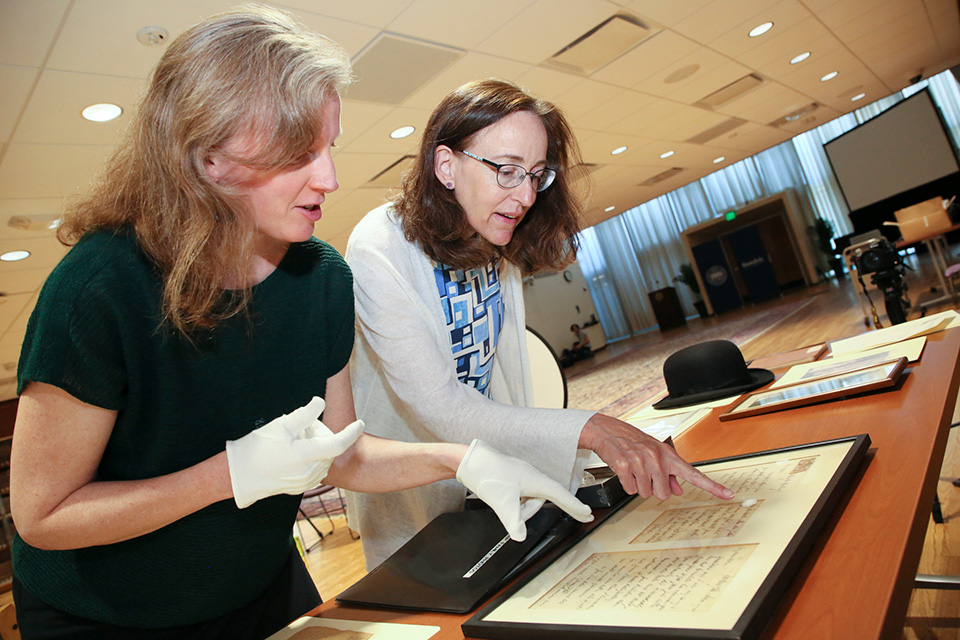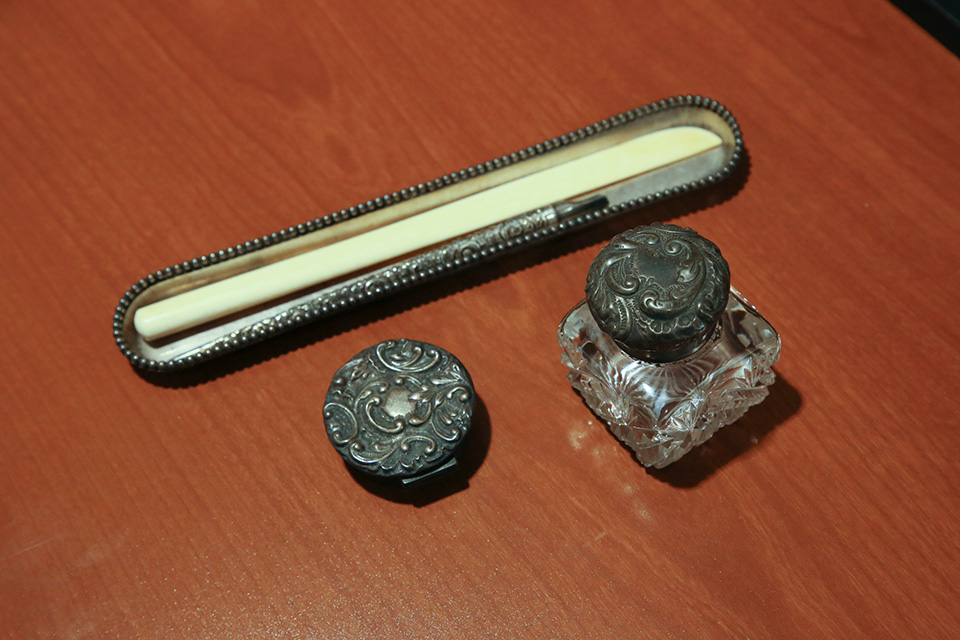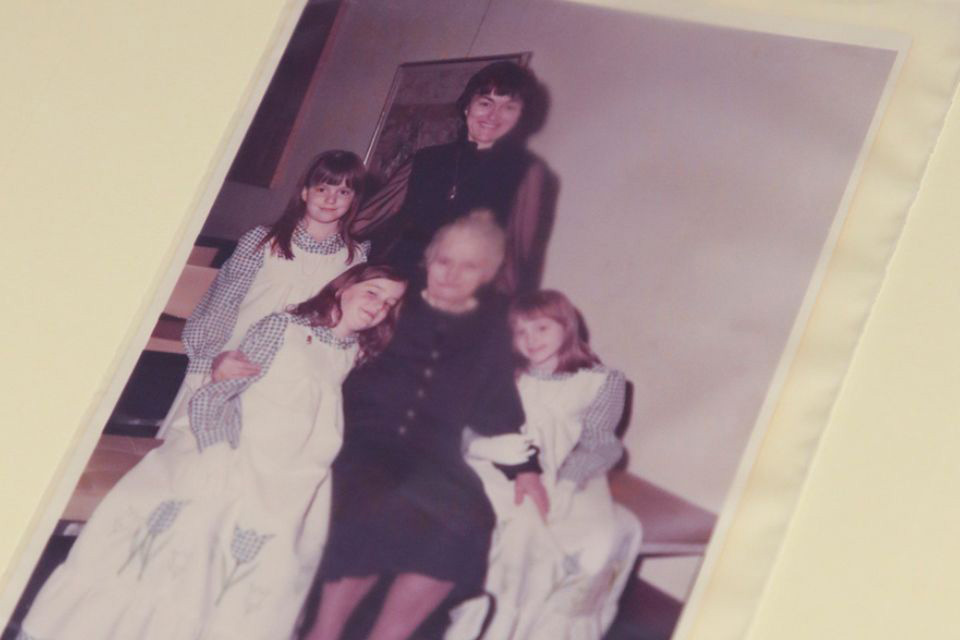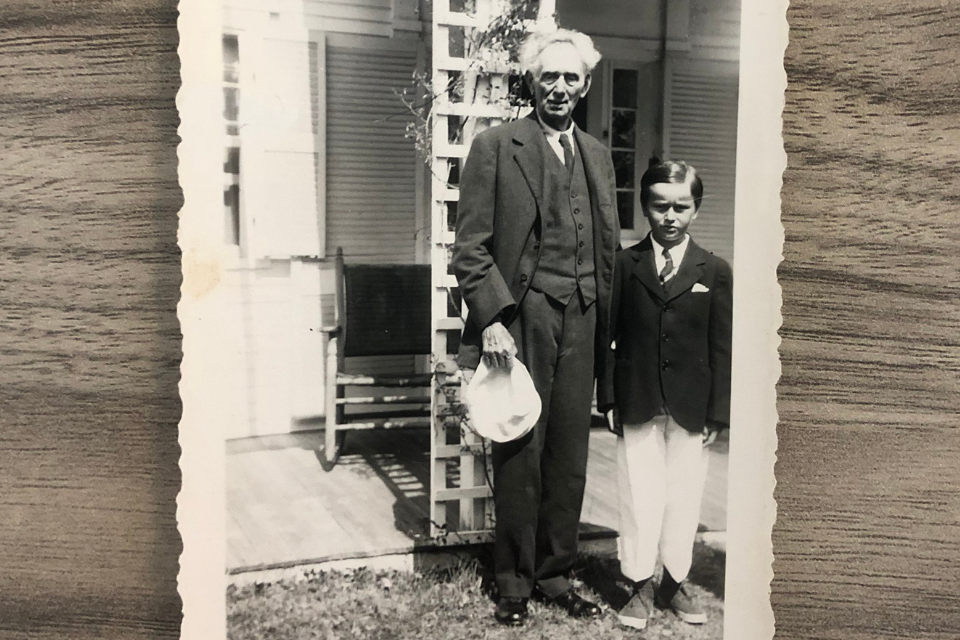Brandeis Alumni, Family and Friends
Louis Brandeis’ Great-Granddaughters Give Historic Family Artifacts to University Archives
September 6, 2022
Just in time for Brandeis' 75th anniversary, the university receives a remarkable trove of Brandeis family artifacts and ephemera including handwritten letters to and from political luminaries, photos, an exquisite fountain pen, and even a personal 1941 telegram from Franklin D. Roosevelt.
Brandeis University is delighted to announce that a major gift of Louis D. Brandeis family belongings – from personal correspondence, annotated books, and documents to writings by Brandeis’ children and a stately rocking chair – has been added to the Louis Dembitz Brandeis Collection by his three great-granddaughters.
Susan Brandeis Cahn, Anne Brandeis Popkin, and Louisa Brandeis Popkin gave the objects to their venerable great-grandfather’s namesake in a gesture that is not only expansive and historic, but which reflects their abiding devotion to the memory and legacy of this great man and all that he stood for in his own lifetime. Their gift includes 12 pieces of furniture and eight personal artifacts – such as inkwells, a pen rest, and a brass carriage clock – 220 books, many of which have inscriptions from Justice Brandeis and other Brandeis family members, and approximately five linear feet of manuscript materials, including correspondence and photographs. With parts of the collection being digitized by the Robert D. Farber University Archives and Special Collections, within the Brandeis University Library, these items – long-cherished by every generation of Brandeis’ descendants – will become available to the world.
The Alumni Association recently caught up with the sisters in a lively and informative conversation in which they shared the unique meaning and usage that these objects have had for them and the entire Brandeis family, all the way back to the man himself. The staff of Archives and Special Collections, which houses and cares for this collection and many others, had kindly brought a selection of items from the sisters’ donation to the room where the interview took place.
“My sisters and I consider it an honor and a responsibility to carry forward our great-grandfather's legacy,” said Susan Brandeis Cahn. “We hope these objects help students, faculty, researchers, and the public learn about Louis D. Brandeis, the person, so they’ll be inspired to make their own contributions to society.”
The sisters knew that the existing collection at their great-grandfather’s namesake university was the right home for their cherished possessions, and they were delighted to have the opportunity to talk about them and share family stories that have been passed down from generation to generation.
“We've always been amazed at what an incredible university bears our great-grandfather’s name,” said Susan, “and we all loved learning about it growing up. After family, there is nothing he valued more than education, so it is the absolute perfect place for these things, and for his heritage.”
The collection boasts a wealth of fascinating objects, including primary-source (original) documents, most produced by Brandeis and his immediate family, and an array of material on American legal history, the Progressive and Zionist movements, the U.S. Supreme Court, and the early years of Brandeis University.
As Susan, Anne, and Louisa delved into the history behind the memorabilia, many Brandeis ancestors informed the conversation, as when Louisa read aloud from various precious documents in the collection. One example is written on delicate pale gray paper in the confident penmanship of a child who has practiced the art of script: a contract between Louis D. Brandeis and his young daughters, Susan and Elizabeth, regarding the polishing of their father’s shoes. With the formality of a legal document, the girls solemnly agreed to this daily chore, for five cents each per week, and that if they missed a day “for illness or any other good reason, they may ask the said Louis Brandeis permission to do the shoes the next morning.”
FDR sends respects
One of the most powerful artifacts that the sisters donated to the Louis Dembitz Brandeis Collection is a telegram, dated October 5, 1941 – the day Justice Brandeis died – from President Franklin Delano Roosevelt to Brandeis’ widow Alice. In it, FDR expresses his heartfelt sympathies, which Louisa read aloud.

The telegram from President Franklin Delano Roosevelt to Justice Brandeis’ widow Alice upon his death reads as follows:
“My heart goes out to you and yours, in the loss of a loved and loving husband and father, who was my faithful friend through long years. Mrs. Roosevelt joins me in this assurance of deepest sympathy.
The whole nation will bow in reverence to the memory of one whose life in the law – both as advocate and as judge – was guided by the finest attributes of mind and heart and soul. In his passing, American jurisprudence has lost one whose years, whose wisdom, and whose broad spirit of humanism made him a tower of strength.
Franklin D. Roosevelt”
Photo Credit: Mike Lovett
“What I appreciate most about the telegram,” said Louisa, “is that it conveys a sense of both his professional brilliance and who he was as a person. It makes me wonder, in retrospect, if there was a public versus private persona or if it's simply that he reserved that part of himself for his family and the people he was close to.”
Family lore
Other objects donated by the sisters summoned more lighthearted conversation. The “Brandeis bed,” as they call it, has been in the family since the early 1900s. A handsome, cherry-stained twin with an elegantly carved footboard and headboard, it was typically kept in one of the guest rooms, first at Justice Brandeis and Alice’s Washington D.C. home – when Justice Brandeis was serving on the United States Supreme Court – and, later, in their Chatham, Massachusetts, home. Over the years, the bed acquired an impressive bit of lore, which the sisters continue to espouse wholeheartedly.
“When friends came to visit,” said Anne, “we’d tell them that it was the Brandeis bed and that, if they slept in it, they would gain some of Louis’ intelligence. If they had children, they were most interested in making sure the kids slept in it. So, the bed was not only utilized as a place where guests could sleep but for passing on Justice Brandeis’ intelligence and values to our friends.”
Over the years, at one time or another, all the grandkids, great-grandkids, cousins, nieces, nephews, and so on, slept in it, in order to avoid missing out on a chance for even a nap-sized dose of Justice Brandeis' intelligence. Of her son, Ascher, Susan affirmed that “Louis’ great-great-grandson definitely feels that he benefited from sleeping in that bed.”
Imparting Brandeis values
The sisters’ collection holds a particularly personal meaning, as they inherited it directly from their mother, Alice Brandeis Popkin, and grandmother, Susan Brandeis Gilbert, two strong role models who believed in Brandeis University and the importance of continuing the legacy of Justice Brandeis. Like Justice Brandeis, both women were lawyers at a time when few women worked outside the home, let alone had careers as attorneys.
“Our grandmother was instrumental in the founding of the university,” said Anne, “and she worked with the Brandeis University National Women’s Committee, which became the Brandeis National Committee. As a regent for the University of the State of New York from 1935 to 1949, she knew that education was the best way to maintain the values and legacy of her father. She and our mother cared deeply about Brandeis University and its role in preserving what Louis Brandeis valued most: an engaged citizenry, which he knew required an educated citizenry. Obviously, we were influenced by these incredible women, and we are proud to pass on this stewardship to the university.”
Family was a recurring topic throughout our conversation. Whether discussing the Brandeis summer home on Cape Cod, letters Justice Brandeis wrote to his granddaughter Alice, or his timeless sense of humanity and socio-political convictions, his devotion to his family is as legendary as his judicial achievements.
Each of Justice Brandeis’ three great-granddaughters are moved by his commitment to family:
“Family was so important to him,” said Susan. “He sincerely appreciated them and so many of these objects in the collection are evidence of that.”
“Unlike many people who have power and position today,” said Anne, “he was genuinely close to his family.”
“Something that I really appreciate about our family, as a whole and over time,” said Louisa, “is the sincere focus on people and understanding others.”

The existing Louis Dembitz Brandeis Collection includes Justice Brandeis’ black derby hat, which was donated by his grandson, the late Frank Gilbert, and Gilbert’s wife, Ann. The derby was there amongst the other ephemera during the interview, which made Justice Brandeis yet more central to the conversation.
In addition to family, Justice Brandeis’ life was anchored in a deep love for his country, an unwavering conviction that part of his mission in life was to improve human condition, and a singular intellectual tenacity that led to lasting socio-political accomplishments.
After practicing as an attorney for 28 years, Justice Brandeis was nominated to the Supreme Court of the United States and, after being vehemently opposed by conservative Republicans, was confirmed by a vote of 47 to 22. He served for 23 years, from 1916 to 1939, and enjoyed a distinct renown as someone who was devoted to improving the lives of his fellow man.
“He was a man of incredible integrity, intellect, and a unique combination of Judaism and American values. He dedicated his life to working hard for change and made a lasting impact on social policy and the democratic culture of our country, which is being threatened today. Telling his story now, through the collection, is more important than ever.” — Susan Brandeis Cahn, great granddaughter of Louis D. Brandeis
“President Liebowitz is committed to further emphasizing Brandeisian values by allowing access to these important family artifacts,” said Anne, “and the timing – just as we’re about to begin celebrating the university’s 75th anniversary – is pure kismet. With the library digitizing the collection, as well as creating a location where these memorabilia will be displayed, visitors to campus and people on the other side of the world will be able to study them.”
“Louis Brandeis was a man of values, character, and social justice,” added Anne, “and Brandeis is where these objects can have the most impact in carrying on our great-grandfather’s legacy.”
To be sure, Justice Brandeis’ distinctive, deeply venerated ethos is as germane to the human condition in the present as it was a century ago when he sat on the Supreme Court. The university’s commitment to making his personal and professional possessions available for learners around the globe adds a contemporary dimension to his legacy, reaffirming its profound historical might while reigniting its ever-pertinent humanistic message.

The Louis Dembitz Brandeis Collection will be supported in part by a new fundraising campaign being coordinated by the Brandeis National Committee, a membership organization that has supported Brandeis since 1948. The campaign, “The Legacy of Louis: Inspiring Inquiry,” will launch this fall and help support the overarching institutional goals and ethos in President Liebowitz’s Framework for the Future.
About the Author

Annie is senior development writer in advancement communications. Before joining Brandeis in January 2022, she was a writer at Dartmouth College. As a longtime freelance journalist and radio commentator, she has covered art, culture, travel, and education for the New York Times, the Washington Post, the Boston Globe, Art in America, Art New England, NPR, and many other outlets. She is the lucky mom of two great kids.















